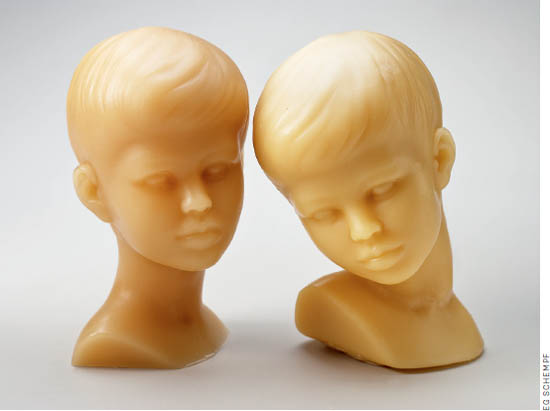After reading this interview, “poet” should definitely be added to the description of American artist Peregrine Honig. Also on that list: painter, sculptor, drawer, and master of gorgeous installations. She was one of the artists on Bravo’s first season of Work of Art: her exquisitely bizarre, carnival-themed show then being exhibited at the Brooklyn Museum was in the final episode. Peregrine’s work is thoughtful, considered, and beautifully executed—poetic, one might even say.
JC—Do you remember the first time you felt like an artist?
PH—I remember drawing in the sun on my mother’s apartment porch when I was four. My hand was cooperating with my mind. A Belgian man and his girlfriend were staying downstairs. He was smoking near me. He looked at what I was drawing and told me I was too good to draw on both sides of a sheet of paper. The memory of this moment is fresh: the airborne dust, the smell of tobacco, the texture of the wood under my paper. I had never been praised in the form of advice.
JC—Did you ever want to be anything else?
PH—My mother would let me walk to the Castro Theater and watch Thin Man movies. I wanted to be a spy or the wife of a spy—until I saw a scene where a dead body fell out of a shipping crate.
JC—Where did you study art?
PH—I went to the Kansas City Art Institute (KCAI), where I learned how to speak and write in art. I had amazing teachers, but I didn’t graduate. I dropped out during my fourth year. Academia is about disseminating ideas, not about teaching people how to create or be creative. If you are a creator, you must create. No amount of academia can produce someone with an innate ability to create. There are some days I am ashamed by my lack of degrees, and other days I wish I were less hindered by academia.
JC—Who were those amazing teachers, and what did you learn from them?
PH—Jack Lemon, the founder of Landfall Press, and his trusty sidekick Steven Campbell, and my early advocate and translator Melissa Rountree—all came to me through hard work, incredible timing, and good luck. Russell Ferguson taught me, “Draw what you see and what you know.” My favorite teacher, Lester Goldman, died in 2005, and I very much miss learning from him. His celebration of mundane material allowed me to work fearlessly with grocery bags and paper doilies.
JC—How do you know if a piece is heading in the wrong direction?
PH—If the start is a struggle, I am in the wrong place. I prefer to start many times with the muscle memory of failure rather than push out what I am not interested in making. I go through a lot of material if I don’t take a moment and pay attention to whether or not I am in a space to produce.
JC—How do you respond to criticism?
PH—If the writer has a solid handle on their point and their criticism is fresh, sharp, and considered, I experience their criticism with grace and confidence. If the critique is bland and self-centered, with a dated agenda, I respond to it with disdain. Either way, criticism is nerve-wracking. When the work comes down, criticism and show postcards are all that remains.
JC—What does your inner critic sound like?
PH—The clock ticking. Time is my loudest and most influential critic.
JC—Are you bothered by creative blocks? How do you get through them?
PH—Blocks are part of my creative process. I cannot always make and generate without addressing the spaces in between tactile progress. The pause is important to honor, no matter how different it feels in comparison to the rich and fruitful harvest where my body falls into place with my mind and the material. I love graffiti in small towns—“Sex, Drugs, Rock ’n’ Roll” sprayed on a rock or scratched into a tree near a pile of rusting cans, sun-bleached labels fluttering off glass. Perhaps my taste is more refined, but the sentiment remains. Intimacy, cocktails, and music are excellent lubricants in and out of a rut.
JC—Describe how you feel when your creativity is truly flowing.
PH—Being in a state of creation is a serious turn-on. I’m vulnerable, and when I finally fall asleep, I have fantastic dreams.

Intimacy, cocktails, and music are excellent lubricants in and out of a rut.